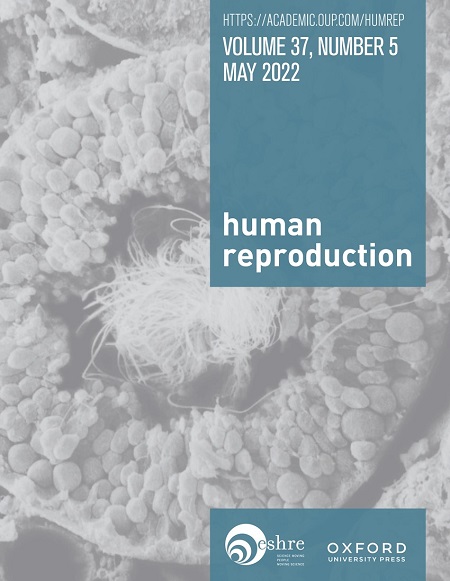Performance of algorithms using wrist temperature for retrospective ovulation day estimate and next menses start day prediction: a prospective cohort study
IF 6
1区 医学
Q1 OBSTETRICS & GYNECOLOGY
引用次数: 0
Abstract
STUDY QUESTION Can algorithms using wrist temperature, available on compatible models of iPhone and Apple Watch, retrospectively estimate the day of ovulation and predict the next menses start day? SUMMARY ANSWER Algorithms using wrist temperature can provide retrospective ovulation estimates and next menses start day predictions for individuals with typical or atypical cycle lengths. WHAT IS KNOWN ALREADY Wrist skin temperature is affected by hormonal changes associated with the menstrual cycle and can be used to estimate the timing of cycle events. STUDY DESIGN, SIZE, DURATION We conducted a prospective cohort study of 262 menstruating females (899 menstrual cycles) aged 14 and older who logged their menses, performed urine LH testing to define day of ovulation, recorded daily basal body temperature (BBT), and collected overnight wrist temperature. Participants contributed between 2 and 13 menstrual cycles. PARTICIPANTS/MATERIALS, SETTING, METHODS Algorithm performance was evaluated for three algorithms: one for retrospective ovulation day estimate in ongoing cycles (Algorithm 1), one for retrospective ovulation day estimate in completed cycles (Algorithm 2), and one for prediction of next menses start day (Algorithm 3). Each algorithm’s performance was evaluated under multiple scenarios, including for participants with all typical cycle lengths (23–35 days) and those with some atypical cycle lengths (<23, >35 days), in cycles with the temperature change of ≥0.2°C typically associated with ovulation, and with any temperature change included. MAIN RESULTS AND ROLE OF CHANCE Two hundred and sixty participants provided 889 cycles. Algorithm 1 provided a retrospective ovulation day estimate in 80.5% of ongoing menstrual cycles of all cycle lengths with ≥0.2°C wrist temperature signal with a mean absolute error (MAE) of 1.59 days (95% CI 1.45, 1.74), with 80.0% of estimates being within ±2 days of ovulation. Retrospective ovulation day in an ongoing cycle (Algorithm 1) was estimated in 81.9% (MAE 1.53 days, 95% CI 1.35, 1.70) of cycles for participants with all typical cycle lengths and 77.7% (MAE 1.71 days, 95% CI 1.42, 2.01) of cycles for participants with atypical cycle lengths. Algorithm 2 provided a retrospective ovulation day estimate in 80.8% of completed menstrual cycles with ≥0.2°C wrist temperature signal with an MAE of 1.22 days (95% CI 1.11, 1.33), with 89.0% of estimates being within ±2 days of ovulation. Wrist temperature provided the next menses start day prediction (Algorithm 3) at the time of ovulation estimate (89.4% within ±3 days of menses start) with an MAE of 1.65 (95% CI 1.52, 1.79) days in cycles with ≥0.2°C wrist temperature signal. LIMITATIONS, REASONS FOR CAUTION There are several limitations, including reliance on LH testing to identify ovulation, which may mislabel some cycles. Additionally, the potential for false retrospective ovulation estimates when no ovulation occurred reinforces the idea that this estimate should not be used in isolation. WIDER IMPLICATIONS OF THE FINDINGS Algorithms using wrist temperature can provide retrospective ovulation estimates and next menses start day predictions for individuals with typical or atypical cycle lengths. STUDY FUNDING/COMPETING INTEREST(S) Apple is the funding source for this manuscript. Y.W., C.Y.Z., J.P., S.Z., and C.L.C. own Apple stock and are employed by Apple. S.M. has research funding from Apple for a separate study, the Apple Women’s Health Study, including meeting and travel support to present research findings related to that separate study. A.M.Z.J., D.D.B., B.A.C., and J.P. had no conflicts of interest. TRIAL REGISTRATION NUMBER NCT05852951.求助全文
约1分钟内获得全文
求助全文
来源期刊

Human reproduction
医学-妇产科学
CiteScore
10.90
自引率
6.60%
发文量
1369
审稿时长
1 months
期刊介绍:
Human Reproduction features full-length, peer-reviewed papers reporting original research, concise clinical case reports, as well as opinions and debates on topical issues.
Papers published cover the clinical science and medical aspects of reproductive physiology, pathology and endocrinology; including andrology, gonad function, gametogenesis, fertilization, embryo development, implantation, early pregnancy, genetics, genetic diagnosis, oncology, infectious disease, surgery, contraception, infertility treatment, psychology, ethics and social issues.
 求助内容:
求助内容: 应助结果提醒方式:
应助结果提醒方式:


